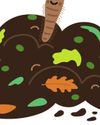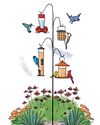يحاول ذهب - حر
The Sequence Of Spring Migration
February/March 2019
|Birds & Blooms
From early arrivals like blackbirds to latecomers like flycatchers, find out when your favorite fliers will pass through.

Every year, a grand parade sweeps northward across the continent. Vast numbers of individuals take part, but they aren’t marching up Main Street—they are spreading out from coast to coast, and even offshore. This famous procession is the spring migration of birds.
No matter where you are, the phenomenon lasts for months. Along the southern border it starts in January, while in the far north you might not see movement until March or even later. One thing is true everywhere: Certain birds come early in the order of migration, others much later. If you know what to expect, it’s easy to plan your birding adventures.
Of the species that famously lead the way, most spend winter in the southern states, moving north as early as possible. Red-winged blackbirds and common grackles are good examples. Tough, adaptable birds that feed on almost anything, they can survive the risk of heading into cold regions.
However, not all of these early fliers travel short distances. Purple martins spend the first part of winter in South America but start their trek early, with advance scouts reaching Florida and Texas by the middle of January. In the far West, rufous and Allen’s hummingbirds that wintered in Mexico move north up the California coast by early February.
هذه القصة من طبعة February/March 2019 من Birds & Blooms.
اشترك في Magzter GOLD للوصول إلى آلاف القصص المتميزة المنسقة، وأكثر من 9000 مجلة وصحيفة.
هل أنت مشترك بالفعل؟ تسجيل الدخول
المزيد من القصص من Birds & Blooms

Birds & Blooms
Better Off with Bats
Rethink the unsung heroes of the night and why you should support them
2 mins
October / November 2025

Birds & Blooms
Late Bloomers to Love
Keep garden colors going strong with fall perennials
3 mins
October / November 2025

Birds & Blooms
IN THE COMPANY OF OWLS
On any given morning, you'll find A.J. Berard trekking through the woods and mountains of Montana with a 45-pound pack and his Siberian huskies.
3 mins
October / November 2025

Birds & Blooms
Tree TLC
Discover tips for planting and tending to trees, from the roots up
2 mins
October / November 2025

Birds & Blooms
EASY. BREEZY Black-Eyed Susans
Planting rudbeckia, with petals aglow in honeyed yellow, fiery orange and velvety burgundy, is like sprinkling sunshine throughout the garden.
3 mins
October / November 2025

Birds & Blooms
Social and Adaptable
Find out how the house finch became a backyard regular
1 mins
October / November 2025

Birds & Blooms
Tales from the UNDERSTORY
The dense forest floor is the perfect setting to nest and forage
3 mins
October / November 2025
Birds & Blooms
Tracking Tiny Travelers
Small, numbered rings reveal the secrets of hummingbird migration
2 mins
June/July 2025

Birds & Blooms
The Dirt on Millicompost
Learn how to use millipedes to increase soil health
2 mins
June/July 2025

Birds & Blooms
THE PERFECT PAIRING
Learn the best ways to use an abundance of blooms to attract more birds and beautify your feeder space
3 mins
June/July 2025
Translate
Change font size

